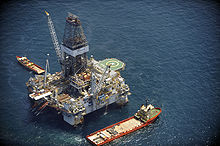After 100 days, Deepwater Horizon oil spill still threatens Gulf coast
Saturday, July 31, 2010

Image: International Bird Rescue Research Center.

Image: Barry Bena/US Coast Guard.
Wednesday marked the 100th day since the beginning of the Deepwater Horizon oil spill, and although the leaking well was recently capped, the estimated three million or more barrels of oil already in the Gulf of Mexico are still causing trouble for many residents of the Gulf coast.
There are still many unanswered questions about the long-term impact of the spill, including how it has affected the environment and natural habitats of the Gulf as well as whether residents of the area will be able to return to their jobs and livelihoods now that the leak has been capped. US government officials say that, even after the oil well is permanently sealed, workers will still have a lot to do, including the removal of around 20 million feet (6.1 million metres) of containment boom. "I would characterize this as the first 100 days. There's a lot of work in front of us," said Rear Admiral Paul Zukunft of the US Coast Guard.
Authorities will use submarines to assess damage underwater, while teams on the ground assess the shoreline. While removing oil from beaches is expected to be fairly straightforward, cleaning the marshlands will be particularly difficult, as boats are needed to maneuver through small channels and workers are unable to stand on solid ground. At least 638 miles (1,027 kilometres) of the Gulf coast have been hit by the oil.
The government is focusing on both cleaning sensitive coastal regions and looking for underwater oil plumes, but is also probing into what may have been the largest accidental oil spill. The US Justice Department, as well as Louisiana, Mississippi, and Alabama, are all investigating what contributed to the disaster. The Washington Post reported one team is looking into whether a close relationship between BP and government regulators played a role in the spill. The Post also said that Deepwater Horizon operator Transocean as well as oil services group Halliburton were being investigated.
BP officials say that they will try to perform the "static kill" process on Monday, a process which involves pumping a thick mixture of mud and cement down into the cap currently stopping the leak. At the end of next week, one of two relief wells currently being drilled should reach the leaking well, and officials will then know if the static kill has worked. It is hoped that this "bottom kill" operation will be able to permanently seal the damaged well.
Even though BP is close to sealing the oil reservoir, it still faces legal battles, economic struggles, and internal changes. On Tuesday, BP announced Tony Hayward would step down from his position as the company's chief executive. His replacement, American Bob Dudley, will be the first non-British CEO of the company.
On Thursday, lawyers met at Boise, Idaho hearing to determine how around 200 various lawsuits against BP will play out. Depending on whether the suits can be consolidated, BP could be facing years of legal disputes. BP, Transocean, and Halliburton had already blamed each other for the disaster during a May hearing before the US Senate. Federal regulatory officials were criticized for allegedly taking bribes and not thoroughly inspecting the oil rig.
The company also reported a quarterly loss of US$16.9 billion and said it has allocated US$32.2 billion to pay for the spill. BP has a US$20 billion fund to help make up for the massive losses of the Gulf fishing, oil, and tourism industries and will pay damages for each of the millions of barrels of oil lost in the disaster.
BP says that it is the "responsible party" for cleaning up the spill because it owned the leaking well and had leased the Deepwater Horizon oil rig, but claims that it is not responsible for the entire spill.
Sources
- Andrew Gully. "100 days in, Gulf spill leaves ugly questions unanswered" — Agence France-Presse, July 28, 2010
- "US scientist says much surface Gulf oil 'dispersed'" — BBC News, July 28, 2010
